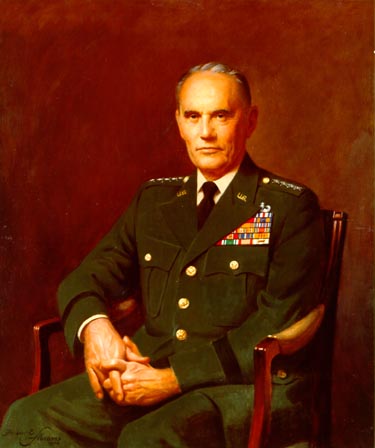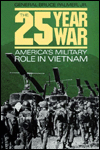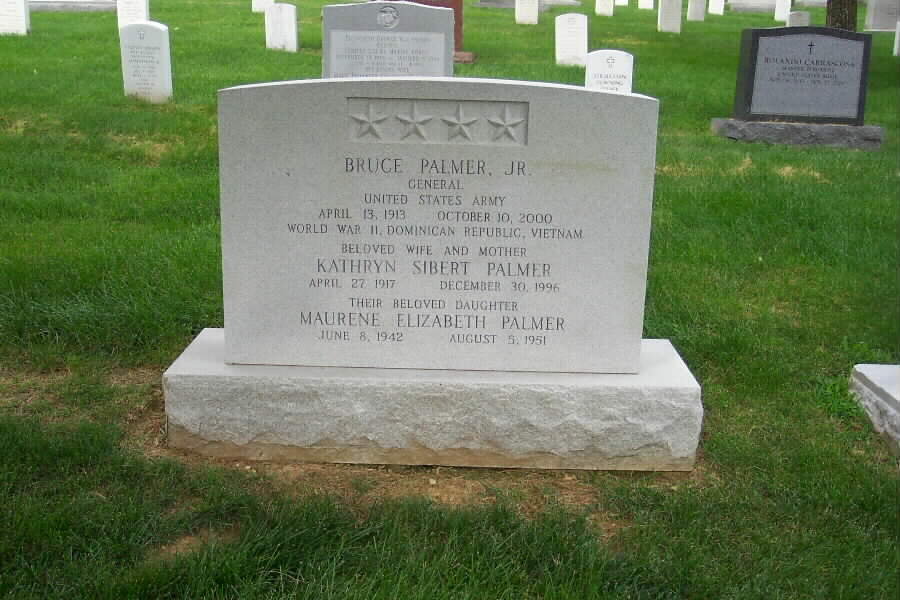From a contemporary press report
Bruce Palmer Jr., 87, a top Army commander in Vietnam and a former Army Vice Chief of Staff who later wrote a well-received book on the Vietnam War, died October 10, 2000 at Inova Mount Vernon Hospital, Virginia, after a stroke. He lived at the Fairfax retirement community at Fort Belvoir, Virginia.
General Palmer became Deputy Commanding General to General William C. Westmoreland in Vietnam in 1967 and Army Vice Chief of Staff, again under Westmoreland, in 1968.
General Palmer was the Army’s acting chief of staff in 1972 and retired in 1974 as commander in chief of the Army Readiness Command at MacDill Air Force Base in Florida.
General Palmer was born in Austin, Texas.
His father was an Army brigadier general and a grandfather received the Medal of Honor during the Civil War.
The future vice chief of staff was assigned to the cavalry after graduating sixth in his class from the U.S. Military Academy at West Point, New York, in 1936.
He served in the Southwest Pacific Theater during World War II. After the war, he became a tactics instructor in the infantry school at Fort Benning, Georgia.
He was a 1952 graduate of the Army War College and was its deputy commandant from 1959 to 1961.
One of his more visible pre-Vietnam assignments came in 1965 when he commanded more than 20,000 U.S. troops sent to quell strife in the Dominican Republic between the military junta and rebel forces.
Other assignments included a tour as White House liaison officer to the Army’s chief of staff and deputy chief of staff.
After retiring from active duty, he served two years as executive director of the Defense Manpower Commission, a task force designated by Congress to study the transition to an all-volunteer force.
From 1976 to 1984, he was a senior fellow at the American Enterprise Institute and a military member of the CIA’s military review panel and the agency’s Center for the Study of Intelligence.
In retirement, Gen. Palmer publicly questioned the way the military handled the Vietnam War.
He once wrote that U.S. forces relied too much on massive firepower at the expense of “professional skill and soldierly qualities.”
“It’s so difficult for the military to admit they made a mistake,” he told The Washington Post in 1976.
“That was the case in Vietnam. It was the duty of the people at the top to speak out, but we are trained to obey orders, not question them.
“I think it’s a mistake for the Joint Chiefs [of Staff] to say, ‘This is not a military matter,’ ” he added. “It’s not that simple. They say, ‘War is too complicated to leave to the generals.’ Well, the converse is also true.”
In 1984, the University Press of Kentucky published General Palmer’s book “The 25-Year War: America’s Military Role in Vietnam.” David Chanoff, a Vietnam War expert writing in The Post in April, placed the book among the best on Vietnam and lauded Gen. Palmer for “a professional military history, detailed, technical, yet personal and highly readable.”
General Palmer also wrote “Intervention in the Caribbean: The Dominican Crisis of 1965,” published in 1989 by the University Press of Kentucky.
His decorations included five Army Distinguished Service Medals, an Air Force Distinguished Service Medal, a Silver Star, Legion of Merit, Bronze Star and Air Medal. He also held the director of central intelligence’s National Intelligence Distinguished Service Medal.
He was a past senior warden of Emmanuel Episcopal Church in Alexandria and past president of the West Point Society of the Washington region.
His wife, Kathryn Sibert “Kay” Palmer, whom he married in 1936, died in 1996.
A daughter, Maurene Elizabeth Palmer, died in 1951
Survivors include a son, Bruce III, of Valrico, Fla.; a daughter, Robin Palmer Sessler of Kettering, Ohio; eight grandchildren; and a great-granddaughter.
The General’s parents, Brigadier General Bruce Palmer (January 27, 1878-July 28, 1958) and Madeline Harding Palmer (November 18, 1878-September 6, 1958) are buried in Section 30, Grave 387, of Arlington National Cemetery. His grandfather, George Henry Palmer, Major, United States Army and Medal of Honor Recipient, is buried in Section 3 of Arlington National Cemetery.
PALMER, JR. BRUCE, General United States Army (Retired)
On October 10, 2000. Beloved husband of the late Kay S. Palmer; loving father of Robin Sessler, Bruce Palmer, III and the late Maurene Palmer; grandfather of eight and great grandfather of one. Funeral services will be held Monday, October 23, 11 a.m. at Ft. Myer Chapel with interment to follow at Arlington National Cemetery with full military honors. In lieu of flowers donations may be made to the West Point Fund Association of Graduates, USMA or to the Arthritis Foundation.
Courtesy of the United States Army
Bruce Palmer, Jr., was born in Austin, Texas, on 13 April 1913. He graduated from the United States Military Academy in 1936 and was commissioned a second lieutenant and served with the 8th Cavalry at Fort Bliss, Texas, 1936–1939. He married Kay Sibert in 1936.
Palmer was promoted to first lieutenant, June 1939, and served as regimental adjutant, June–September 1939; he graduated from the Cavalry School at Fort Riley, Kansas, 1940; was a troop and squadron commander of the 6th Cavalry (Mechanized), 1940–1942; was promoted to temporary ranks of captain, October 1940, and major, February 1942; served in the Operations Division of the War Department General Staff, 1942–1943; was promoted to temporary lieutenant colonel, February 1943; was chief of staff of the 6th Infantry Division in Southwest Pacific operations in World War II, 1944–1945; was promoted to temporary colonel, January 1945, and permanent captain, June 1946, and major, July 1948; commanded the 63d Infantry in the Korean occupation, 1945–1946; was chief of plans and operations of the First Army, 1947–1949; was instructor of tactics and then director of instruction at the Infantry School, Fort Benning, 1949–1951; concurrently completed the basic airborne course; graduated from the Army War College, 1952; was secretary of the general staff and chief of the Plans Division, United States Army, Europe, 1952–1954; was promoted to permanent lieutenant colonel, July 1953; was commander of the 16th Infantry, 1954–1955; served on the faculty of the Army War College, 1955–1957; was deputy secretary of the General Staff and White House liaison officer, Office of the Chief of Staff, 1957–1959; was promoted to temporary brigadier general, August 1959; was deputy commandant of the Army War College, 1959–1961; was assistant division commander of the 82d Airborne Division at Fort Bragg, 1961–1962; was promoted to permanent colonel, June 1961, and temporary major general, May 1962; was chief of staff of the Eighth Army, Korea, 1962–1963; was assistant deputy chief of staff for plans and operations, 1963–1964, and deputy chief of staff for military operations, 1964–1965; was promoted to permanent brigadier general, February 1963, and temporary lieutenant general, July 1964; was commander of Task Force 120 and United States Land Forces, Dominican Republic, May 1965; was concurrently commander of United States Forces and Army Forces and deputy commander of the Inter-American Peace Force in operations in the Dominican Republic, May 1965–January 1966; was commander of the XVIII Airborne Corps, 1965–1967; was commander of the II Field Force, Vietnam, and deputy commander of the United States Army, Vietnam, 1967–1968; was promoted to temporary general, August 1968, and served as vice chief of staff of the United States Army, 1 August 1968–30 June 1972; was acting chief of staff of the United States Army 1 July–11 October 1972; provided managerial continuity at the top of the Army during the Westmoreland-Abrams interregnum, supervised the continuing drawdown of Army forces from Vietnam and related Army-wide readjustments, and prepared major revisions in Army organizational structure; resumed duties as vice chief of staff; was commander in chief of the United States Readiness Command, 1973–1974; retired from the Army, September 1974.
The Artist
Herbert Elmer Abrams (1921–), who also painted Generals William C. Westmoreland and Creighton W. Abrams, Jr., has given television lectures on painting, has been interviewed on radio, and has written in American Artist on the work of his distinguished teacher, Frank Vincent DuMond. A 1975 film, A Different Light, on Abrams and his art won the Keith L. Ware Annual Award for Excellence in Newspapers, Magazines, Radio, and Television, and the Department of Defense’s Thomas Jefferson Award for outstanding achievement in promoting a fuller understanding of the mission of the armed forces.
Bruce Palmer, Jr.
By Herbert Elmer Abrams
Oil on canvas, 42″ x 36″, 1975
20 January 2007:
Thank you very much for your heartening website. Would you please consider adding to the web page of Brigadier General Bruce Palmer, Sr. that his son-in-law and daughter are buried near him – in addition to his son, General Bruce Palmer, Jr. His daughter is my mother, Marcella Palmer Blanchard, and her husband, Colonel Wendell Blanchard, (4th Armored Division Reserve Command at Bastogne) is my father; their graves are near those of her father, Bruce, Sr., and brother, Bruce Palmer, Jr., and their wives in Section 30.
Thank you in any case! –Lydia Blanchard
ALMER, BRUCE JR
- GEN US ARMY
- VETERAN SERVICE DATES: 08/31/1933 – 08/31/1974
- DATE OF BIRTH: 04/13/1913
- DATE OF DEATH: 10/10/2000
- DATE OF INTERMENT: 10/23/2000
- BURIED AT: SECTION 30 SITE 389 LH
ARLINGTON NATIONAL CEMETERY
PALMER, KATHRYN M
- DATE OF BIRTH: 04/27/1917
- DATE OF DEATH: 12/23/1996
- BURIED AT: SECTION 30 SITE 389 LH
- ARLINGTON NATIONAL CEMETERY
WIFE OF PALMER, BRUCE JR GEN US ARMY
PALMER, MAURENE ELIZABETH
- DATE OF BIRTH: 06/08/1941
- DATE OF DEATH: 08/05/1951
- BURIED AT: SECTION 30 SITE 389 LH
- ARLINGTON NATIONAL CEMETERY
DAUGHTER (MINOR CHILD) OF PALMER, BRUCE JR GEN US ARMY
Michael Robert Patterson was born in Arlington and is the son of a former officer of the US Army. So it was no wonder that sooner or later his interests drew him to American history and especially to American military history. Many of his articles can be found on renowned portals like the New York Times, Washingtonpost or Wikipedia.
Reviewed by: Michael Howard



